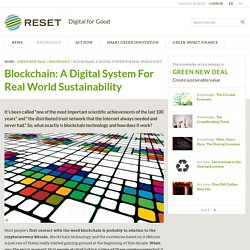

A Deeper Look at Cryptocurrencies - Bitcoin, Ethereum and Ripple - The Red. In 2017, Bitcoin, a digital currency launched in 2009, monopolized international finance headlines.

On 1st January 2017, a Bitcoin was worth 972 USD while one year later, on 1st January 2018, you would have needed to invest 14.000 USD to buy a single token, down from nearly 20.000 USD on 17 December 2017. Considering the same timeframe, its market capitalization rose from 15,5 billion to 233 billion US dollars, after having reached its peak on 17 December 2017 at 335 billion (Cryptocurrency Market Capitalizations). Bitcoin, however, is just the tip of the iceberg. Underneath there is a whole universe of cryptocurrencies (nearly 1400) which value and market capitalization has skyrocketed in the last months of 2017.
Le bitcoin, gouffre énergétique et péril climatique. Le bitcoin, ce doux rêve de libertarien, va-t-il tourner au cauchemar pour le climat ? C’est ce que concluent deux études des plus sérieuses. Elles avancent que la généralisation de cette monnaie virtuelle (cryptomonnaie), par ses seules émissions, conduirait la planète à dépasser le seuil fatidique des 2 °C de réchauffement – la limite fixée par l’accord de Paris – en moins de deux décennies. Et que cet « or 2.0 » consommerait plus d’énergie que l’extraction d’or véritable, de cuivre, de platine ou de terres rares pour produire la même valeur marchande. Ce spectre de la demande énergétique hante le monde du bitcoin – né en 2009 – depuis plusieurs années déjà. On estime que sa consommation, évaluée à au moins 58 térawattheures (58 milliards de kilowattheures) par an, équivaudrait à celle de l’Autriche ou à entre dix et vingt fois celle de l’ensemble des data centers de Google.
Les deux nouvelles études, encore plus alarmistes, relancent le débat. Untitled. Most people's first contact with the word blockchain is probably in relation to the cryptocurrency Bitcoin.

Blockchain technology and the currencies based on it (Bitcoin is just one of them) really started gaining ground at the beginning of this decade. When was the exact moment that people started taking notice of these cryptocurrencies? It was probably when someone using the pseudonym of Satoshi Nakamoto published a white paper in 2008, explaining for the first time what exactly Bitcoin is. 2008 was also the year when the collapse of the US investment bank Lehman Brothers caused a stock market crash and set off a global financial crisis that went on for years.
The crisis demonstrated to the world the inherent risks hidden in the financial system - primarily due to the centralisation of financial institutions. Because basic blockchain technology and the code of the Bitcoin protocol are both open source, they were picked up by numerous developers and further refined. 1. 2. The-Future-is-Decentralised. Block chains, distributed ledgers & the future of sustainable development The potential of block chains to disrupt industrial sectors, commercial processes, governmental structures or economic systems seems to know no bounds.

We suggest that the transformative power of block chain technology should not be seen as a threat to existing systems of governance; rather, it should be seen as an opportunity for national and international institutions to defend the rights of those they represent and to accelerate our collective progress towards meeting the United Nations’ Sustainable Development Goals. Blockchains for Sustainability. Crowd-based reporting mechanisms replace costly and corruptible auditors to ensure qualitative and quantitative Sustainable Fair Trade without delays.

Fair Trade has been around for 70 years, linking consumers with an awareness for fair wages to producers willing to respond to their demands. Today the concept of Fair Trade is increasingly linked to a broader social and environmental responsibility: Sustainable Fair Trade. The common pitfalls for Fair Trade are the cost of uncorrupted verification of standards and their chain of custody. With the rise of decentralized digital network technology, first implemented in 2009 as a core component of the crypto-currency Bitcoin, the barriers to Fair Trade have changed. Blockchain Top Trends In 2017. Kryptowährungen: Eine Grafikkarte nur zum Minen.